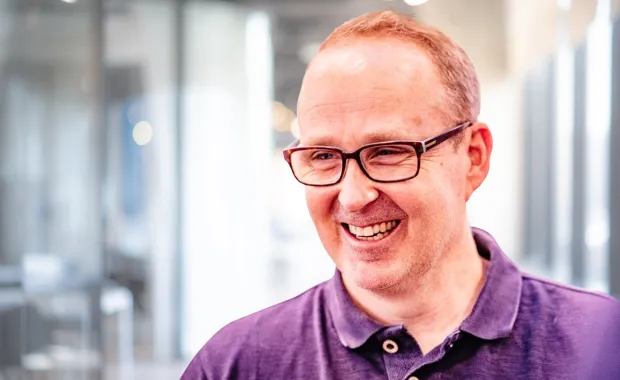Thought the only way up from Architect was to launch a software product? CGI member Doug Sykes shares his career journey and how CGI has played a huge part in it.
November 2021
My career background is technical; I started out in the very beginning as a Software Engineer. Over the years, I moved up to Technical Lead and then Team Lead and eventually into Architecture.
As I progressed, I became quite fascinated with how teams of developers deliver software effectively - how some development teams were able to deliver, while others with the same skill sets seemed to struggle.
When I joined CGI, I was very much in an architecture role, working on government projects. From there however, I have slowly transitioned into being Director of Consulting Services (DCS), a more customer-facing role in which I look after customer accounts, and teams who are delivering services to our customers.
Typically, the types of people who end up in this kind of role have been project managers or something similar. However, my technical background really helps me because I understand problems from a technical perspective and what the best possible solution would be for our customers.
I also feel that I’m proof that strong technical leaders can succeed in less tech-focused, upper management roles as well.
The skills I apply in my current role
One of my best skills is ‘root cause analysis’ - I can get to the core of a problem very quickly. In the tech world, this saves a lot of time.
In the business world, I equate it to keeping focus on the "problem", which is a lot harder to actually do in a business context. Business problems may not immediately be apparent, or the root cause might be something beyond the digital world’s remit to solve.
So, it is important to ensure that at all times, as technical people, we evaluate if the correct solution is a digital one. In this way, proper technical knowledge and being able to communicate well are both critical.
As my software engineering roles were always on the client-side - figuring out what customers want and why - I’ve learned that a lot of the time, there is a disconnect between what a business requires and what actual software engineering is trying to deliver. My job now is to break down a problem and decide whether to apply a technical or non-technical solution. Sometimes the best solution isn't a technical one!
In terms of new skills I've picked up in this role, I’ve learned how to make sure that whatever you're working on is actually what the requirement is, or what the customer's asked for - otherwise, you're just wasting your time. If you're making assumptions, you’ll probably come up with the wrong answers.
The biggest challenge of adjusting to a new career path
One of the biggest personal challenges of my transitional career path has been that I'm a technical person and most comfortable around technical people. Often when I'm in front of customers - especially people who are more business-focused - I can struggle a bit.
That's one of the things that I have to be very conscious of. Technical people can be very abrupt and come across as such, so it’s something I am always actively working on. I also need to be aware of using too much technical jargon to answer questions and not showing the right amount of empathy to solve the customer’s problems.
How CGI has helped me
At CGI, we have mentors and career champions. All of mine have been fantastic people who encouraged me to grow and work in different ways and in different areas. One of the great things about CGI is that there are opportunities for rotation if you’re feeling stale in your job.
My line managers, too, have been fantastic. Also, the resources available in terms of training are unparalleled in any organisation I've worked for - and I’ve worked for a few!
The five year plan
For me, my role is all about developing a quality software engineering capability across my business unit at CGI. The plan is to eventually implement repeatable and quality engineering frameworks so we can broaden that up to the wider BU.
At the same time, it’s about remaining true to our customer base and making sure that what we are implementing underpins what our customers want: the intention is to compel them to come back to us with more work, thanks to the inherent quality of the services they receive.
Some advice for those starting at CGI
If you’re just starting out at CGI, here’s some advice to help you ensure you’re successful here;
- Spend time understanding CGI as a business model. The organisational structure can be quite confusing and challenging. Understanding where you fit within that structure takes a while to get your head around at first, but it’s important.
- Grow your network within CGI as quickly as possible. Participate in as many of the events available to you as possible, take advantage of the training and the communities that are set up, and really get to know your peers.
- Buy into the corporate culture - it’s real and the vision coming from leaders is as exciting as they make it out to be.
There is a massive career framework within CGI that clearly maps up career progression across all aspects of consultancy, from the technical, to project management, to business stream - and you can also change between those career streams if you want.
In my opinion, the sky’s really the limit within CGI. It's just up to you as an individual to identify what you want and go after it.
I really recommend taking a look at the careers on offer at CGI - it’s been a terrific turning point for my career.





